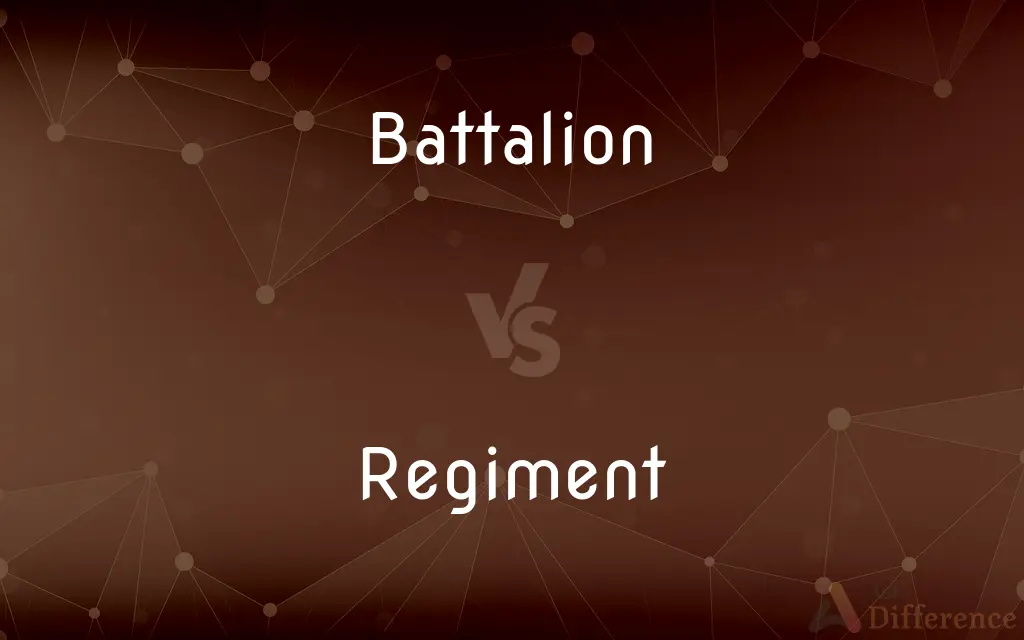Battalion vs. Regiment — What's the Difference?
By Urooj Arif & Fiza Rafique — Updated on March 14, 2024
A battalion is a military unit size typically commanded by a lieutenant colonel, smaller than a regiment. Regiments are larger units that encompass multiple battalions, often with a rich historical identity.

Difference Between Battalion and Regiment
Table of Contents
ADVERTISEMENT
Key Differences
A battalion, in military terminology, represents a sizable unit of soldiers, usually consisting of between 300 to 800 soldiers. It is commanded by a lieutenant colonel and is part of a larger brigade or regiment, depending on the country's military structure. On the other hand, a regiment is a larger unit that includes multiple battalions, typically commanded by a colonel. The size of a regiment can vary greatly but generally encompasses thousands of soldiers.
The organization and role of a battalion can vary significantly across different military branches and countries. It often comprises several companies and is capable of independent operations, supported by its own administrative and logistical units. Whereas regiments, beyond their tactical and operational capabilities, often serve as key elements of military heritage and tradition, maintaining their own unique identities, colors, and ceremonial duties.
Battalions are more likely to be deployed as tactical units within larger operations, focusing on specific combat or support roles within the brigade or division framework. Regiments, while also capable of deployment, often serve broader strategic purposes and may be responsible for larger operational areas or more complex missions.
The term "battalion" is used consistently across various types of armed forces, including infantry, armor, and artillery, indicating its tactical and operational flexibility. Regiments, however, while universal in concept, can vary more significantly in their structure and role from one country to another, reflecting national military traditions and organizational preferences.
In modern military operations, the importance of battalions as modular, adaptable units capable of rapid response and specific task fulfillment has increased. Conversely, regiments, while still vital for organizational and ceremonial purposes, have seen their tactical and operational roles evolve, with emphasis on larger scale strategy and unit identity.
ADVERTISEMENT
Comparison Chart
Command
Typically commanded by a lieutenant colonel
Usually commanded by a colonel
Size
300 to 800 soldiers
Several thousand soldiers
Structure
Comprises several companies
Encompasses multiple battalions
Function
Operational and tactical unit, can operate independently
Larger strategic and operational scope, maintains traditions
Flexibility
High, adaptable to specific missions
Less flexible, focuses on broader strategy
Deployment
Frequently deployed in specific roles within larger units
May serve broader strategic purposes or remain undeployed
Heritage and Identity
Less emphasis compared to regiments
Strong historical and ceremonial identity
Compare with Definitions
Battalion
Used in various military branches, emphasizing its operational flexibility.
The armored battalion was crucial in the success of the mission.
Regiment
Maintains rich traditions and identity, often with unique colors and ceremonies.
The regiment paraded its colors on the anniversary of its founding.
Battalion
A military unit size commanded by a lieutenant colonel, consisting of several companies.
The battalion moved out at dawn, ready for the day's operations.
Regiment
A military unit larger than a battalion, commanded by a colonel, with multiple battalions.
The regiment's history was filled with tales of bravery and sacrifice.
Battalion
Can operate independently, with its own support units.
The engineering battalion established a bridge under challenging conditions.
Regiment
Reflects national military traditions in its structure and role.
The regiment's structure was unique to the country's armed forces.
Battalion
Part of larger brigade or regiment structures.
The battalion was the third to join the brigade's composition.
Regiment
Encompasses a broad operational scope, potentially including various types of battalions.
The regiment included infantry, artillery, and support battalions.
Battalion
Focuses on tactical and specific combat roles.
The reconnaissance battalion gathered vital intelligence on the enemy.
Regiment
Serves strategic purposes within the military organization.
The regiment was responsible for securing a large operational area.
Battalion
A battalion is a military unit, typically consisting of 300 to 1000 soldiers commanded by a lieutenant colonel, and subdivided into a number of companies. In some countries, battalions are exclusively infantry, while in others battalions are unit-level organizations.
Regiment
A regiment is a military unit. Its role and size varies markedly, depending on the country, service and/or a specialisation.
Battalion
A military unit typically consisting of a headquarters and two or more companies, batteries, or similar subunits.
Regiment
A military unit of ground troops consisting of at least two battalions, usually commanded by a colonel.
Battalion
A large body of organized troops.
Regiment
A large group of people.
Battalion
A great number
Battalions of ants.
Regiment
To form (troops) into a regiment or regiments.
Battalion
(military) An army unit having two or more companies, etc. and a headquarters. Traditionally forming part of a regiment.
Regiment
To put (things) into systematic order.
Battalion
An army unit having two or more companies, etc. and a headquarters; forming part of a brigade.
Regiment
To subject (people) to strict control and rigid order.
Battalion
Any large body of troops.
Regiment
(military) A unit of armed troops under the command of an officer, and consisting of several smaller units; now specifically, usually composed of two or more battalions.
Battalion
(by extension) A great number of things.
Regiment
Rule or governance over a person, place etc.; government, authority.
Battalion
To form into battalions.
Regiment
(obsolete) The state or office of a ruler; rulership.
Battalion
A body of troops; esp. a body of troops or an army in battle array.
Regiment
(obsolete) Influence or control exercised by someone or something (especially a planet).
Battalion
An infantry command of two or more companies, which is the tactical unit of the infantry, or the smallest command which is self-supporting upon the battlefield, and also the unit in which the strength of the infantry of an army is expressed.
Regiment
(obsolete) A place under a particular rule; a kingdom or domain.
Battalion
To form into battalions.
Regiment
A regimen.
Battalion
An army unit usually consisting of a headquarters and three or more companies
Regiment
(transitive) To form soldiers into a regiment.
Battalion
A large indefinite number;
A battalion of ants
A multitude of TV antennas
A plurality of religions
Regiment
(transitive) To systematize, or put in rigid order.
Regiment
Government; mode of ruling; rule; authority; regimen.
But what are kings, when regiment is gone,But perfect shadows in a sunshine day?
The law of nature doth now require of necessity some kind of regiment.
Regiment
A region or district governed.
Regiment
A body of men, either horse, foot, or artillery, commanded by a colonel, and consisting of a number of companies, usually ten.
Regiment
To form into a regiment or into regiments.
Regiment
To form into classified units or bodies; to systematize according to classes, districts or the like.
The people are organized or regimented into bodies, and special functions are relegated to the several units.
Regiment
To organize and manage in a uniform and rigid manner; to control with a strict discipline.
Regiment
Army unit smaller than a division
Regiment
Subject to rigid discipline, order, and systematization;
Regiment one's children
Regiment
Form (military personnel) into a regiment
Regiment
Assign to a regiment;
Regiment soldiers
Common Curiosities
What is the primary role of a battalion?
The primary role of a battalion is to serve as an operational and tactical unit, capable of performing specific missions within larger military structures.
Can battalions operate independently?
Yes, battalions can operate independently, equipped with their own administrative and logistical support units.
What is the significance of regiments in military tradition?
Regiments hold significant historical and ceremonial importance, often maintaining unique identities, traditions, and colors.
How does the command structure differ between a battalion and a regiment?
Battalions are typically commanded by lieutenant colonels, while regiments are usually commanded by colonels.
How does a regiment differ from a battalion in terms of size?
A regiment is larger than a battalion, encompassing several battalions and consisting of several thousand soldiers.
What makes regiments less flexible than battalions?
Regiments are less flexible due to their larger size and broader strategic focus, compared to the more tactically focused and adaptable battalions.
How are battalions integrated into larger military operations?
Battalions are frequently deployed as tactical units within larger operations, focusing on specific combat or support roles.
Do all countries use the same battalion and regiment structure?
No, the structure and role of battalions and regiments can vary across countries, reflecting different military traditions and organizational preferences.
Are battalions specific to certain types of armed forces?
No, battalions are used across various types of armed forces, including infantry, armor, and artillery, reflecting their operational flexibility.
What role do support units play in a battalion?
Support units within a battalion provide necessary logistical, administrative, and medical services, enabling the battalion to operate efficiently and independently.
What is the importance of regimental colors and ceremonies?
Regimental colors and ceremonies are important for fostering unit pride, identity, and continuity, reflecting each regiment's unique history and traditions.
Do regiments participate in modern military operations?
Yes, regiments participate in modern military operations, but their roles may focus more on strategic oversight and maintaining unit traditions.
Can the size of a battalion vary?
Yes, the size of a battalion can vary significantly, generally ranging from 300 to 800 soldiers, depending on its role and the military's organizational structure.
How is a regiment's history preserved and honored?
A regiment's history is preserved and honored through traditions, ceremonies, and the maintenance of regimental colors, as well as historical records and memorials.
What makes a battalion a crucial element of military strategy?
A battalion's crucial role in military strategy comes from its operational flexibility, ability to respond rapidly to tactical situations, and capacity for independent action within larger missions.
Share Your Discovery

Previous Comparison
Tho vs. Though
Next Comparison
Oval vs. EllipticalAuthor Spotlight
Written by
Urooj ArifUrooj is a skilled content writer at Ask Difference, known for her exceptional ability to simplify complex topics into engaging and informative content. With a passion for research and a flair for clear, concise writing, she consistently delivers articles that resonate with our diverse audience.
Co-written by
Fiza RafiqueFiza Rafique is a skilled content writer at AskDifference.com, where she meticulously refines and enhances written pieces. Drawing from her vast editorial expertise, Fiza ensures clarity, accuracy, and precision in every article. Passionate about language, she continually seeks to elevate the quality of content for readers worldwide.














































